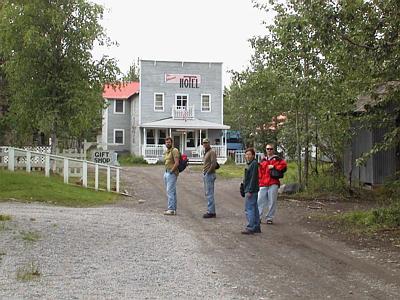30 June, 2000
June 30, 2000
Don Lindsay (PSU grad student) and I befriended a local McCarthy resident
this morning. His name was Tom and he has been working for the St. Elias
backcountry guiding service for the past 10 years. It was a great way to
learn about the history of the McCarthy area, which we discussed over
breakfast.
In 1900, two prospectors named Jack Smith and Clarence Warner spotted a large
green spot on the mountainside along the Kennicott Glacier. Located 5 miles
north of the present town of McCarthy, the green spot turned out to be one of
the richest ore deposits of copper ever found. The ore primarily consisted
of thick deposits of Chalcocite, a grey, soft, copper sulfide mineral with a
composition of 80% copper. A few years later a group of wealthy easterners -
the Guggenheim brothers and J.P. Morgan - bought the mining claim from Smith
and Warner. In 1906 the Kennecott Mines Company was formed. It later became
the Kennecott Copper Corporation. The mining company was to be named after
the Kennicott Glacier, but the company name was misspelled when incorporation
papers where submitted. The town and glacier are spelled Kennicott. The
company and mines are spelled Kennecott.
The next challenge was getting the copper from the mines to a processing and
shipping location. In 1908 a railroad was started at Cordova, which is
located along the coast of Alaska. The railroad reached Kennicott (196 miles
away) three years later. In 1911, the Kennecott mines were opened. During
this time there was a high demand for copper to be made into wiring for the
new electrical transmission lines that had been recently invented by Thomas
Edison. As a result, the Kennecott Mines were very lucrative at the outset.
The town of Kennicott grew quickly - there were up to 300 people in the mill
camp, with 300 miners working in the mines. A number of recreational
opportunities were provided in Kennicott. As a company town, it had a
reputation as being very proper and employed strict conduct rules.
It did not take long for an alternative economy to follow the opening of the
Kennecott Mines. The town of McCarthy, located 6 miles to the south of
Kennicott at the terminus of the glacier, sprang into existence with
restaurants, saloons, pool halls, and numerous other businesses. These
businesses provided services to not just the miners of Kennicott, but other
surrounding mining camps as well.
The mines peaked in 1925. By the mid-1930s three things had happened that
made it difficult for the Kennecott Mines to continue operations. The price
of copper had fallen significantly, the quality of the ore had declined, and
the cost of maintaining the railroad had soared. The mines officially closed
in 1938. The last train left Kennicott and McCarthy in November of that
year. The railroad bridge that crossed the Kennicott River was destroyed by
the outburst flood in 1940. A fire wiped out three-quarters of McCarthy in
1947.
So there you have it - a digression into the history of the place where this
research project is based. Thanks to Tom the backcountry guide for the
information.

Downtown McCarthy - during the 1920s this was a bustling town with numerous hotels, saloons, and other businesses to support the mining camp of Kennecott located 5 miles away. Pictured (from left to right) is Andrew Fountain, Don Lindsay, Michelle Cunico, and Andrew Malm.

Getting ready to be delivered to the various field sites - Michelle Cunico laces her boots, and Andrew Fountain and Don Lindsay check equipment. All of this gear and the people will be delivered by helicopter tomorrow to Hidden Creek Lake and the Kennicott Glacier.

Contact the TEA in the field at
.
If you cannot connect through your browser, copy the
TEA's e-mail address in the "To:" line of
your favorite e-mail package.
|
